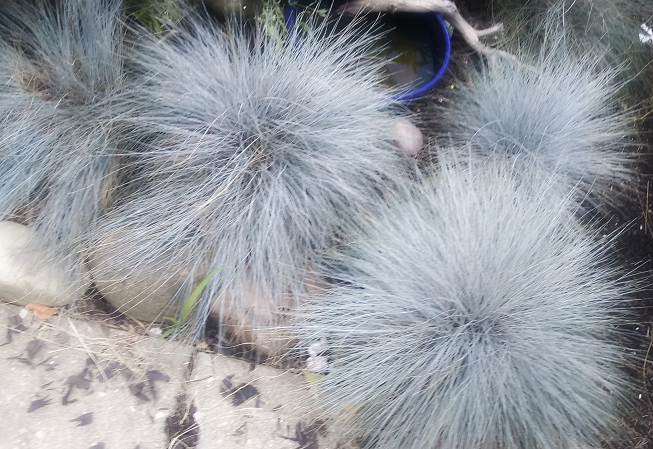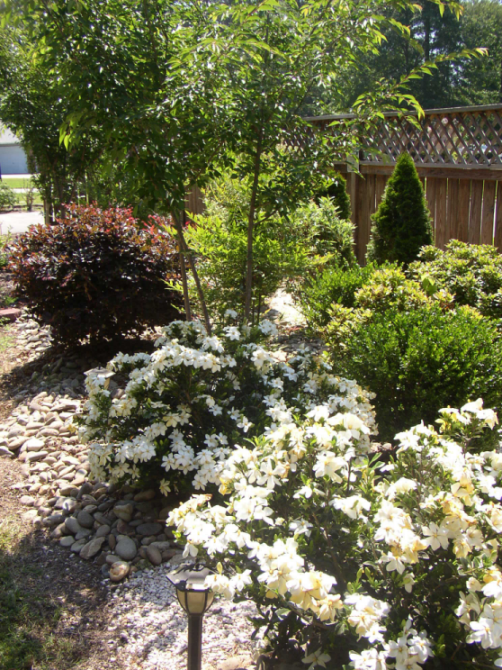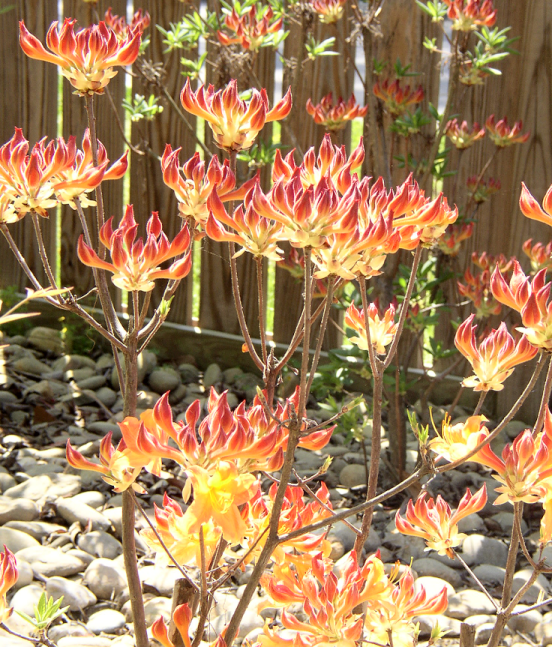

|
|
What That Green Lawn Costs You and The Environment
I admit it.... I am totally anti-lawn. The EPA estimates that the amount of pollution emitted by a lawnmower operating for one hour is equivalent to the amount of pollution emitted by a car driven for approximately 20 miles. And - The National Wildlife Federation states that: -30 to 60 percent of
urban fresh water is used for watering lawns (depending on city). Approximately 20 million acres in the U.S. are planted as residential lawn. Areas of lawn that include only one type of plant, such as grass, offer little habitat value for wildlife. Most people don't use their
front or backyards for living and growing.
My solution to the problem - Clover lawn it
Instead, if you feel the need for an expanse of green.
Better yet, go totally lawnless and use
mulches, hardscapes, native plants and grasses as specimens.
Use solar powered lighting and fountains for pretty water features that
recycle water, with no energy use.
Enjoy your frontyard. Don't just cut grass and look at the lawn. Try xeriscaping with stone, boulders, driftwood, branches and native plants.
Use raised garden beds for
multi-level landscaping and food production.
Use trellises and vines, or your
own fence to grow food for you and the wildlife,
or a floral landscape for scent and colors.
|
|
I had inherited someone's nasty and neglected backyard lawn full of weeds, a
ditch ran all along the backyard, and big bald
spots that are mostly gulf sand instead of soil ..if you have a fenced-in yard, are not close to neighbors who might get a
stray clover or 2, and have no HOA to mess with your head, you can replace the
lawn or parts of it with white dutch clover. It contains an enormous amount of
nitrogen, fertilizes the soil, it's used by many as cover crops and tilled under, or left to grow by gardeners as a
sweet-smelling lawn. I have substituted most of the backyard grass and weeds with clover within 3 fall seasons (zone 8 and 5) of broadcasting the seeds thickly once a month for three months in the fall.. No fighting or trying to eliminate the lawn, just ignoring it. No more food, no more water, no chemicals for you! Clover seed is available at places that sell food lot seeds. |
- No Fuss, it smells wonderful when cut,
and you get happy bees pollinating your garden.
 |
|
Just fling handfuls of the seeds around
just before a rain. i don't scratch it in, i just walk over it.
The white
clover reaches only about 2- 8 inches high. i cut it with a reel mower (because i
love the smell and sometimes i cut more often just to smell it!) you leave the
cuttings and they mulch and fertilize your soil some more with tons of
nitrogen. The seeds become
hardy seedlings very quickly.
Clover is
also grown as wildlife forage by farmers and landowners. Of all the
clovers, the dutch white variety is probably best as lawns. It's shorter and
grows thicker. It needs no extra watering,
fertilizer or care whatsoever. I haven't found it to be invasive or wandering
off beyond my fence areas or other boundaries. I don't need to cut it much
because it's only about 3 inches tall - which is the height i kept my lawn.
Good Reasons To
Eliminate That Needy Expanse of Lawn This is my gone lawn... first and second seasons. xeriscaped and very zen
|

You'd never guess there was once
only a lawn here... |

Rose of Sharon grows
pretty fast, and needs no care, |
The
former lawn is now a landscaped/hardscaped garden, with river rock, pea gravel
paths, mulched with pine straw
• Save time and money that you would normally spend on
mowing and fertilizing grass, and enjoy your yard and gardens.
Reduce Your Lawn - And Help The Pollinators and Wildlife
|
 |
 |
Lawn Gone -
The new xeriscape begins
Tennessee
flagstone path, mulches, atlas cedar tree, spreading junipers
All of these scapes replaced my useless 1/4 acre of lawn.
 |
 |

white pea gravel as a mulch, and achillea growing where once was lawn. These are bee and butterfly magnets. |
 |
90% of the lawn is gone... A water-wise decoratiive front garden takes its place. More "after" photos below.
Use native plant species as ground cover instead of grass.
I use a lot of decorative low-growing, drought resistant grasses as ground cover and
white dutch clover, and evergreen ground covers as well.
Use soaker and
drip hoses to save 90% of your water usage and direct water at the roots -
where plants need it.
Mulch saves water, reduces weeds and prevents erosion. Use organic mulch to improve the soil with nutrients and increase water-holding capacity. Use gravel, river rock, and other decorative stones to add interest and eliminate weeds. You don't have to do it all at once... you can convert a large section at a time each season, and plant it with flowers and shrubs. Hint: Get the larger, more mature plants, and get them at a plant nursery if you wish to see big results in a couple of seasons. I get no less than 1 gallon size for shrubs and 1 quart size for flowers. They're stronger, and more able to take transplant shock and bad weather. It's worth every penny not to plant teeny seedlings or seeds to start your landscape. Don't buy your plants at home centers, go to the source for expert advice and healthy plants. The nurseries also do not practice unsafe pesticide use or deal in GMO plants. |
|
This is the view from my
bedroom window instead of an empty expanse of front lawn.
|

Fragrant Sweetspire
blooms |
|
If you decide on a clover lawn, buy a reel mower. That's what I did.
Getting The Lawn Gone,
and a flower bed prepared. A section at a time... 1. Cover grass with 10 or more l ayers of newspaper (black and white, not color magazine or glossy ) or use brown, not white, cardboard. There is no need to remove the grass first. 2. Make sure the sections overlap one another so that grass and weeds will not come up between the cracks. 3. Thoroughly wet down the newspaper or cardboard. After trial and error, I do this by filling up a wheelbarrow with newspaper and soak with water, rather than lay it out first and dump water on it. This method saves water, and it's heavier and more likely to break down quicker than watering it after you lay it down. It breaks up when lifting from the wheelbarrow and makes a thicker mulch, as opposed to laying sheet-by-sheet. And you don't have to put rocks on top to keep it from flying away as you're layering or watering it. 4. Cover the newspaper or cardboard with a thick layer of mulch or dirt or both (about 6 inches, or more). 5. Allow grass and weeds to die back for 1-2 months. Mine took a little longer than that. The runner-grass is a nightmare. 6. Plant directly through the mulch and newspaper/cardboard.
If you know you’re going to be planting trees or shrubs, dig the holes
before putting down
the layers of newspaper/cardboard and then layer the
newspaper/cardboard around the
holes. |
 |
|
||
|
|
|
Now Isn't this much better
than a needy, work-intensive lawn? It's less work and more reward to grow
a garden.
Xeriscaping makes it water-wise, and using
fragrant and native plants makes
it a low-maintenance retreat that you'll enjoy sitting and relaxing in after a
long day.
Once your lawn becomes a garden, it will grow beautifully with less maintenance. And you get flowers!
Visit
My Zen and Asian Gardens-->
This site uses Watermarkly Software





